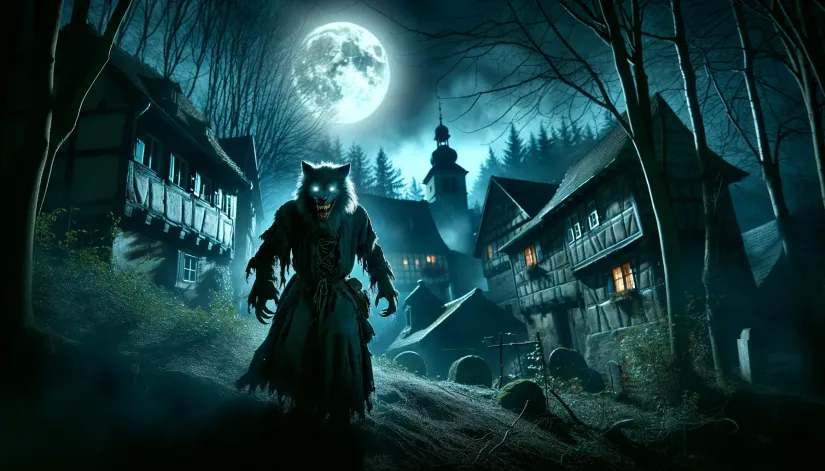Some of you might have heard the shocking story of Peter Stumpp and probably thought, “This can’t be real. It has to be some sort of campfire tale.” Well, the story is real.
Peter Stumpp was a real person. He was a 16th-century farmer accused of some unspeakable crimes—including transforming into a monstrous werewolf and terrorizing his village.
Absolutely wild! So, let’s step into the eerie and bewildering world of 16th-century Europe, where the hysteria around Peter Stumpp (the infamous Werewolf of Bedburg) took hold. A time when superstition ran rampant and the line between myth and reality was often blurred.
And trust us. It’s a gripping tale of murder, superstition, and search for justice that will leave you questioning everything you thought you knew.
In this article:
Who Was Peter Stumpp?
Peter Stumpp (or, according to some historical records, including those from Cologne, Peter Stubbe, Stump, or Stubbe), now synonymous with the dark folklore of werewolves, was born in Epprath, near Bedburg, in the Electorate of Cologne, Germany.
In fact, Stubbe was—by all appearances—a typical German farmer. Yet, beneath this veneer of normalcy lurked a tale so dark and twisted it would etch his name into the fabric of European werewolf folklore forever.
His bizarre journey from a humble farmer to a central figure in one of the most infamous werewolf legends illustrates a fascinating and horrifying transformation.
So, who was Peter Stumpp, and what exactly happened?
Stubbe’s life took a sinister turn after being accused of a series of heinous crimes, including the murder of at least 13 children, two pregnant women, and a chilling litany of alleged cannibalism and incest.
An important note here:
While some sources mention cannibalism and incest, it’s important to note these claims are largely unverified and likely fueled by the sensational nature of the pamphlet “A True Discourse Declaring the Damnable Life and Death of One Stubbe Peeter, a Most Wicked Sorcerer.”
According to this pamphlet (printed in 1590 in London by William Barley), Stubbe claimed—under duress of torture—to acquiring a transformation belt that allowed him to transform into a wolf.
This shocking confession would eventually cement his legacy as the “Werewolf of Bedburg.”
However, since his confession was likely coerced, historians doubt the existence of such a belt (magic or not). Ultimately, after a brief trial, Peter Stumpp was executed on the grim milestone of October 31, 1589.
But is it more to this dark story? And was Stubble a real werewolf?
We must first understand the historical context around those tragic events to answer these questions.
Cologne War and Religious Disputes
The period when Stubble allegedly killed at least 15 people (some sources claim there were, in fact, a lot more victims) was marked by the Cologne War (1583-1588). It was a bloody conflict that deepened the religious divides within the Holy Roman Empire.
Coincidence or not, the infamous Cologne War started in the Electorate of Cologne and was ignited by Archbishop Gebhard Truchsess von Waldburg’s conversion to Calvinism.
It was an unexpected move that challenged the Catholic stronghold of power. And, ultimately, a move that precipitated a war that would draw in powers from the entire region.
It was within this context that accusations of witchcraft and supernatural dealings became increasingly common. People were afraid. Afraid of war and of the church.
Their strong belief in the paranormal was their attempt to explain the unexplainable and to enforce conformity within the troubled society.
So much so that Peter Stumpp’s trial and execution were not isolated incidents. In fact, such accusations and trials were quite common.
And Stubbe’s tragic fate was nothing but a small part of a broader pattern of persecution that sought to root out heresy and otherness from the heart of Europe.
Even the popular texts written by Reginald Scot in England (like his skeptical “The Discoverie of Witchcraft,” 1584) and Johann Weyer in the Holy Roman Empire (the author of “De Praestigiis Daemonum,” 1563) couldn’t offer a strong enough counterpoint to the prevailing narratives of witchcraft and demonic pacts.
Despite these voices of dissent, the hysteria surrounding witchcraft and werewolfism—as epitomized by the case of Peter Stumpp—persisted.
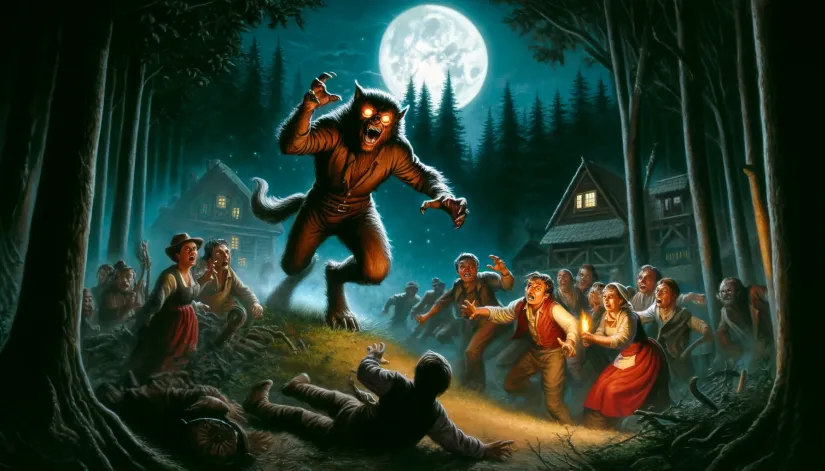
The Horrendous Crimes of Peter Stumpp
Peter Stumpp’s tale morphed from that of a humble German farmer to the protagonist of a nightmarish legend. So what exactly happened? What triggered everything?
At Least 15 Victims and Other Atrocities
Based on the information that was kept until today (like George Bores’s “The Damnable Life and Death of One Stubbe Peeter: A Most Wicked Sorcerer, Murderer and Werewolf – 1590″), Peter Stumpp’s whole horror story began with a chilling catalog of atrocities that cast him as one of the most infamous figures in the annals of criminal history.
As mentioned before, he was accused of the murder of at least 13 children, two pregnant women, and numerous livestock. His actions painted a portrait of a man who had surrendered to the darkest impulses of human nature.
However, Stubbe wasn’t initially accused of being a werewolf. He was just a sadistic murderer. The werewolf narrative emerged during his trial.
The gruesome details of his crimes are recorded with a morbid fascination in “A True Discourse Declaring the Damnable Life and Death of One Stubbe Peeter, a Most Wicked Sorcerer.” In fact, this old pamphlet served as the primary source for many of the allegations against him.
According to this portrayal, Stubbe, under the guise of night and allegedly transformed into a fearsome wolf-like creature (purportedly achieved through a demonic pact), committed acts of unspeakable violence.
His victims—often young and vulnerable—were said to have been savagely torn apart, with Stubbe indulging in the consumption of their flesh.
He continued committing crimes for several years before the Rhenish authorities caught Stubbe in 1589.
What followed was a trial that would captivate and horrify the public.
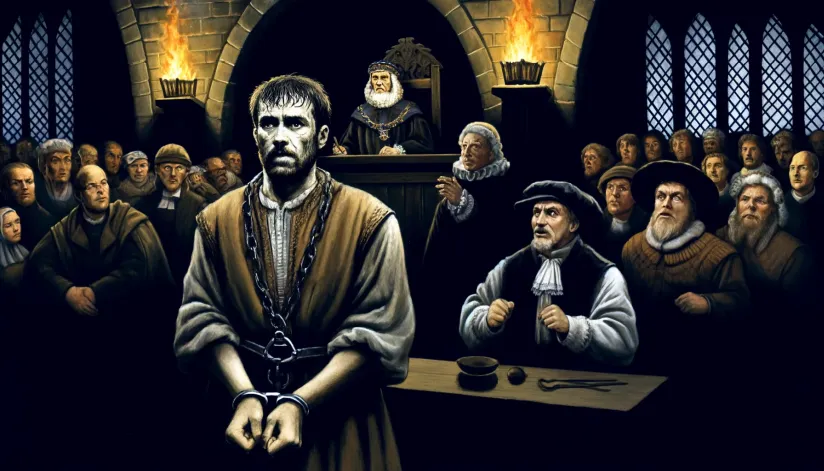
Torture and Forced Confessions
Unfortunately, there isn’t much information about what exactly happened to Stubble after his capture. However, the few available texts talk about Stumpp confessing his crimes under extreme torture and the threat of future agony.
But how much of that is true? It’s hard to say. One thing is for sure: using torture to obtain confessions wasn’t an uncommon practice in the 16th century.
While in custody, Stubbe allegedly confessed to the authorities the gruesome details of his crimes—including the alleged pact with the Devil (wherein Stubbe claimed he was granted a magical belt that enabled his transformation into a wolf).
It’s a bizarre narrative element that aligns more with the folklore of the time than with empirical reality. It’s also a dramatic shift from the initial murder charges to accusations of dealing with the Devil and being a werewolf.
So, what made him claim such things? The multiple murder charges were already enough to convict him to death. Could it have been the extreme duress of torture? Some historians think so.
But even then, Peter Stumpp had NOTHING to gain from such a confession.
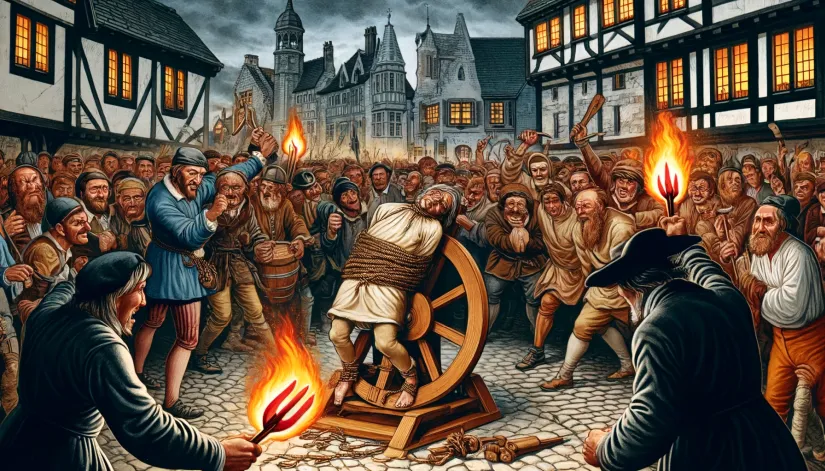
Trial and Gruesome Execution
Again, we don’t know much about what happened during the trial. However, most experts believe that Stumpp was judged primarily based on confessions made under extreme torture, circumstantial evidence, and possibly local rumors.
His execution is a different story. We know it was a public affair—a grotesque spectacle intended to capture the populace’s attention—that lured onlookers from villages and towns all over the Electorate of Cologne.
According to records, Stumpp’s punishment was barbaric—even for those times.
He was first subjected to breaking on the wheel, a horrific torture where all his limbs were broken multiple times. Next, the executioner used the blunt side of an axe to break more of Stumpp’s arm and leg bones.
Then—while still alive—his flesh was ripped off with red-hot pincers. Finally, he was beheaded, and his body burned at the stake.
Sybil (his daughter)and his mistress—both accused of being accomplices—faced execution as well, though their methods were less brutally detailed than Stumpp’s.
But here’s an interesting detail: Peter Stumpp’s execution was indeed a macabre event that drew attention from BOTH the common folk and members of the aristocracy.
This was peculiar. The nobility typically distanced themselves from public spectacles of this nature.
Some historians suggest that because so many nobles were present at Stumpp’s execution, hidden motives might have fueled the spectacle.

Peter Stumpp’s Story Full Timeline
Late 1500s (exact date unknown): Stumpp is born in the village of Epprath, near Bedburg, in the Electorate of Cologne, within the Holy Roman Empire. His early life remains largely undocumented.
1583: Johann Weyer publishes “Pseudomonarchia Daemonum: The False Monarchy of Demons,” further challenging witchcraft persecutions and advocating for a more rational approach to accusations of witchcraft and demonic possession. Weyer’s work contributes to the intellectual climate of skepticism surrounding cases like Stubbe’s.
1584: Reginald Scot’s “The Discoverie of Witchcraft” is published, challenging contemporary beliefs about witchcraft and supernatural phenomena.
1583-1588: The Cologne War rages in the Electorate of Cologne, a conflict rooted in religious disputes between Catholics and Protestants. This period of turmoil and societal unrest sets the stage for the witch hunts and supernatural accusations to come, including those against Stubbe.
Late 1570s to Early 1580s (exact dates unknown): The period when Peter Stumpp is alleged to have committed a series of brutal murders, marking him as a feared figure in the region around Bedburg. The first murder attributed to Stubbe, setting off the sequence of events leading to his capture, is believed to have occurred around this timeframe, though specific documentation is lacking.
1589 (Mid-Year): Peter Stumpp is captured after a series of investigations and manhunts prompted by the increasing violence and the horrifying nature of the crimes. The exact date of his capture is not documented. Still, it is known to have occurred several months before his trial and execution.
1589 (Shortly after Capture): Peter Stumpp’s trial takes place, drawing upon confessions extracted under torture and testimonies from the Bedburg community.
October 31, 1589: Peter Stumpp is executed in a public spectacle, subjected to breaking on the wheel, and then burned at the stake. His daughter and alleged mistress are also executed, accused of being complicit in his crimes.
1590: “A True Discourse. Declaring the Damnable Life and Death of one Stubbe Peeter, a Most Wicked Sorcerer” is published in London. This pamphlet, detailing Stubbe’s crimes and trial, serves as a primary source for much of what is known about his case and helps cement his legacy as the Werewolf of Bedburg.
1920: Montague Summers translates and publishes the pamphlet about Stubbe in English, revitalizing interest in his story and introducing it to a new audience. Summers’ work on witchcraft and the supernatural helps to preserve and disseminate tales of historical witch trials and werewolf stories.
1999: Angela Bourke publishes “The Burning of Bridget Cleary: A True Story,” which examines the social and cultural context of witch trials, including those similar to Stubbe’s.
2017: Cory Barclay publishes “Devil in the Countryside.” This historical fiction novel looks into Peter Stumpp’s life and explores the social and political climate of 16th-century Germany. It is part of a modern resurgence of interest in Stubbe’s story, blending historical facts about werewolves with creative interpretation.
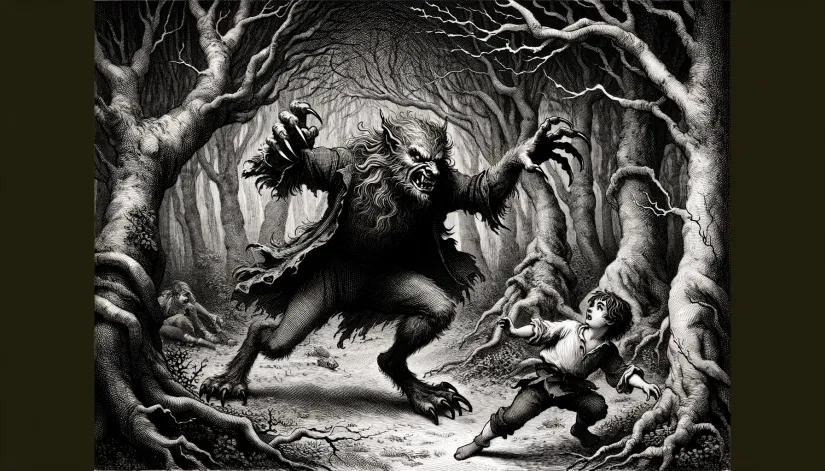
Werewolves in 16th Century Europe
3 Famous Werewolf Legends: Stubbe, Garnier, and Hans
The tale of Peter Stumpp unfolds within a larger narrative of werewolf legends that permeated the continent’s folklore.
16th-century Europe witnessed several notable cases of lycanthropy, including those of Gilles Garnier and Hans the Werewolf. When examined alongside Stubbe’s story, these accounts reveal an intricate mixture of fear, superstition, and the human condition.
Gilles Garnier (known as the “Hermit of St. Bonnot”) was another infamous figure of the time, convicted of lycanthropy on January 18, 1573.
Interestingly enough, Garnier’s case bears many similarities to Stubbe’s.
Both were accused of being werewolves. And both were charged with multiple murders—with Garnier being convicted of killing and cannibalizing several children. Ultimately, both were subjected to public trials and horrific executions.
However, Garnier’s story diverges in its context and the nature of his alleged crimes. For example, he claimed that his transformation into a wolf-like monster was necessitated by the need to feed his starving family.
On the other hand, Hans the Werewolf (a young man from Estonia) presents a contrasting narrative to both Stubbe and Garnier.
Tried in 1651, Hans was also accused of being a werewolf. But unlike Stubbe and Garnier—whose crimes allegedly included cannibalism—Hans’s story focused on his claimed ability to transform into a wolf and the pact with the Devil that granted him this power.
The Devil seems to be the common ground in many of these legends about werewolves.
But the accusations of lycanthropy against Stubbe, Garnier, and Hans (and, to some extent, of another case that happened to Jacques Roulet in France) reflect not only the belief in supernatural entities but also the complexities of human psychology and the societal need to find scapegoats for inexplicable or unsettling events.
Separating Fact from Folklore: Was Peter Stumpp a Real Werewolf?
If anything, the “Werewolf of Bedburg” legend is complex and involves elements of sorcery, demonic possession, and werewolfism. But is there any truth to it? Given the documents that remained from that time, it’s impossible to tell.
However, we can draw a few conclusions based on the historical evidence (even if this proof is quite limited).
First—and this is a common misconception—Peter Stumpp’s legend is more about a sorcerer. The werewolf part came out later during interrogation. Not before.
If we were to analyze this legend purely from the werewolf perspective, we would be wrong. It’s primarily a tale about sorcery and demonic possession.
Stumpp was accused of practicing dark magic and meeting the Devil face to face—which only later led to his transformation into a werewolf. So, the alleged werewolf transformation resulted from him practicing dark witchcraft.
Secondly (unlike what happened in the infamous Beast of Gévaudan’s case), the Rhenish authorities weren’t looking for a lycanthrope suspected of killing all those innocents. They were looking for a murderer. The werewolf story wasn’t even on the table, to begin with.
It’s also important to consider the nature of the evidence presented against Stubbe.
Much of what is known comes from the pamphlets and broadsheets that circulated after his trial. All were sensational in nature and likely exaggerated or fabricated to captivate the audience.
Regardless of the truth, Peter Stumpp’s story has left a lasting impact on werewolf mythology in popular culture. His gruesome tale of dark magic, alleged transformation, and brutal killings has inspired various depictions of werewolves in movies and TV.
Characters like Larry Talbot in “The Wolf Man” and David Kessler in “An American Werewolf in London” echo elements of Stumpp’s legend, blending horror, transformation, and the supernatural.
You can probably draw your own conclusions now.
Frequently Asked Questions
Was Peter Stumpp a real werewolf?
No evidence supports the allegations that Peter Stumpp was a real werewolf.
Did Peter Stumpp actually confess to his crimes?
Stumpp did confess to a series of brutal murders and attacks, including making a pact with the Devil and transforming into a wolf. However, the validity of his confession is highly debated. Historians believe it was likely coerced through torture, a common practice during witch trials.
How was Peter Stumpp caught?
There are no clear accounts of how Stumpp was initially caught. It’s possible that disappearances of livestock and people, along with whispers of dark magic, led to suspicion and, ultimately, his arrest.
What were the accusations against Peter Stumpp?
Stubbe was accused of several horrific crimes, including:
1) Murdering 13 children, two pregnant women, and livestock
2) Making a pact with the Devil
3) Transforming into a werewolf to carry out his attacks
4) Practicing witchcraft
What was the punishment for werewolves in the 16th century?
There wasn’t a specific punishment for werewolves. Still, as Stumpp’s case demonstrates, accusations of lycanthropy often went hand-in-hand with witchcraft. The punishment for witchcraft in the 16th century was typically brutal, usually involving torture, execution by burning at the stake, or breaking on the wheel (as was Stubbe’s fate).
Did Peter Stumpp inspire any famous werewolf stories?
While there’s no single, definitive story inspired by Peter Stumpp, his case undoubtedly contributed to the evolution of werewolf myths in Europe. His story was documented and sensationalized, feeding into existing folklore about shapeshifting creatures.
What evidence existed against Peter Stumpp?
The evidence against Stumpp was largely circumstantial and based on local rumors and fear. As mentioned earlier, there were no physical signs of him being a werewolf, and his confession is considered unreliable.
Was Peter Stumpp mentally ill?
Whether Stumpp suffered from a mental illness is unknown. It’s possible he had some form of psychological condition that could explain his actions. Nevertheless, the lack of proper diagnosis in the 16th century makes it impossible to say for sure.
How does Peter Stumpp’s case compare to other historical werewolf trials?
Peter Stumpp’s case was one of the most notorious werewolf trials in history. It shared similarities with other European witch trials of the time, with accusations of demonic pacts, shapeshifting, and brutal punishments. However, the sheer number of murders attributed to Stubbe makes it stand out from some other cases.

